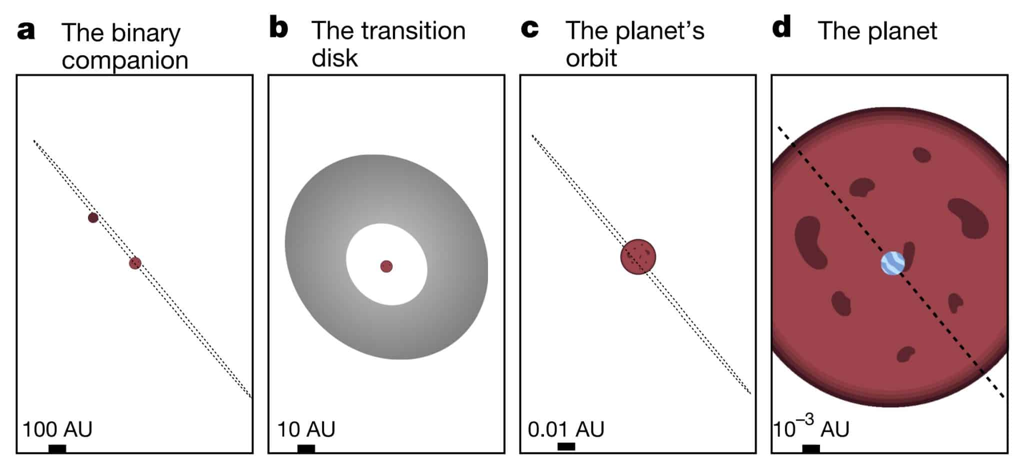Astronomers have detailed the youngest exoplanet discovered using the transit method.
The transit method is one of the primary techniques used to detect exoplanets. It enables scientists to determine the size of an object, identify the presence of an atmosphere, and even assess its composition. Unfortunately, this method is only effective when the system is favorably aligned, allowing exoplanets to pass between us and the star, thus transiting. By observing the changes in the star's light output, researchers can detect the existence of an exoplanet.
According to data from the NASA archive, over 4,300 of the 5,800 confirmed exoplanets have been discovered using the transit method. However, only a few dozen of these transit exoplanets orbit stars that are between 10 and 40 million years old.
It was believed that capturing younger exoplanets using the transit method was nearly impossible, as they are likely obscured by dense dust from the protoplanetary disk. Additionally, at such a young age, they have not yet undergone all stages of formation, making detection more challenging.
Nevertheless, we now understand that the inner part of the disk disperses relatively quickly, while the outer part can sometimes become warped and displaced. This is exactly what happened with the disk of the star IRAS 04125+2902.
Astronomers have been monitoring IRAS 04125+2902 using the TESS space telescope since 2019. This has allowed them to capture 17 transits of the exoplanet IRAS 04125+2902 b. The results obtained were corroborated by observations from the Las Cumbres Observatory telescopes. A paper describing the discovery has been published in the journal Nature.
The variable star IRAS 04125+2902, a T Tauri type star, is located in the Taurus molecular cloud, potentially the closest region of star formation to us, at a distance of 522 light-years from the Solar System. According to the authors of the new scientific paper, IRAS 04125+2902 is approximately 3.3 million years old, meaning its exoplanet is not older than that. Furthermore, it is three times younger than the previous transit record holder.
There are several similarly young stars with exoplanets that have been discovered through direct observations, as well as a few unconfirmed exoplanets identified using the radial velocity method. All these exoplanets are quite massive, with some even nearing the size of brown dwarfs. The new exoplanet IRAS 04125+2902 b, when it "grows up," will become smaller, although it currently has a Jupiter-like size, being about 10.7 times larger than Earth.
Planets aged between 10 and 700 million years are usually large but significantly less dense than their older "siblings." Thus, young gas giants during their first 20-30 million years can be 1.4-2 times larger than Jupiter. The mass of the discovered exoplanet is less than 0.3 times that of Jupiter. This suggests that statistically, it is not a true giant but rather an inflated precursor to a sub-Saturn (four to seven times larger than Earth) or even a sub-Neptune (1.5 to 4 times larger than Earth). This assumption is supported by the fact that the star itself is small — 0.7 times the mass of the Sun. Huge exoplanets are rarely found around small stars.

The inner zone of the protoplanetary disk has dispersed to a distance of about 20 astronomical units (an astronomical unit is the average distance from the Earth to the Sun). In our Solar System, this corresponds to the orbit of Uranus. The exoplanet, with an orbital period of 8.8 Earth days, orbits at a distance of about 0.077 astronomical units from its star (Mercury orbits at 0.39 astronomical units).
Astronomers were able to detect the planet using the transit method because the outer part of the disk is significantly tilted. This tilt could potentially be explained by the star's rotation plane, but it roughly coincides with the orbital plane of the exoplanet. A companion star could have influenced the disk, but its motion also seems to align with that of the star and the exoplanet. Overall, scientists have not been able to explain the disk's tilt.
In computer models of regions with active star formation, the outer areas of protoplanetary disks often shift and warp due to interactions with surrounding objects. For instance, the disk's shape can be altered by material "falling" from the cloud onto the star. Astronomers encounter warped disks, but it is still unknown how frequently they occur.
Based on the mass and size of the planet, it can be inferred that it possesses a sufficiently inflated atmosphere — an excellent target for further observations using the James Webb Space Telescope. New data from the ALMA radio telescopes will help clarify the dynamics of the system. Additionally, the search for similar objects in clusters of young stars should continue. It is possible that many young systems have similarly "warped" disks.